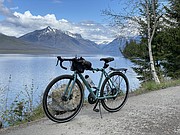Glacier National Park volunteer bike patrol keeps cyclists safe
Visitors looking to beat the mid-summer tourist crush in Glacier National Park propel themselves by bicycle along the park’s most famous artery, the Going-to-the-Sun Road.
Following Lake McDonald on the lower section of the road, biking on a day in early May offers a unique way to experience the park.
At Lake McDonald Lodge is where Lois Ladyn begins her day as a member of the park’s volunteer bike patrol. It’s after this point that the road is closed to motor vehicles, which allows for cyclists to enjoy the ride on the winding road.
The bike patrollers are tasked with doling out park information, offering light mechanical and medical assistance, and reporting serious incidents to the park’s dispatch office by handheld radio.
In 2019, 13 cyclists were trapped when an avalanche blocked the road. Two bike patrollers found them and relayed the information to park rangers. The volunteers then stayed with the cold cyclists for eight hours as the cyclists were eventually evacuated.
Volunteers also educate cyclists about the unique hazards that they may come across. Cyclists and hikers on the road have to be aware at all times of the potential dangers — including avalanches and rock falls, variable weather conditions, and the occasional meandering grizzly bear.
A retired dental hygienist from Bigfork, Ladynn has been volunteering at the park for nearly 30 years in various roles. Glacier’s magic drew Lyden and her husband to move to the area from Florida in the early 1990s. When she first visited, Glacier’s natural beauty felt like a secret, especially in comparison with Yellowstone, Montana’s other national park.
“The secret’s out,” Ladyn said.
Going on patrol, Ladyn wears a backpack, and bear spray is harnessed around her fluorescent yellow top. She has a plastic bag tied to her pack for collecting any litter she might come across. On her chest is a pin honoring her over 4,000 hours of volunteer service in the park.
“Oh, I got that a long time ago,” she said.
It’s clear that Ladyn is not in this for the recognition, or, obviously, the money. In addition to her weekly five-hour patrol shifts, she makes the 100-mile round-trip drive to the lodge another two times per week.
In June, she transitions to an on-foot wilderness patrol, offering much of the same services to hikers. She’s been volunteering, mostly assisting with conservation and wildlife projects, since 1995. From 2004 to 2012, she worked with researcher Kate Kendall, collecting hair samples to track and count the park’s bear population.
It’s because of her love for the park’s ecosystem that she thinks of her other mission as one of conservation. As more people are visiting the park in recent years, preserving what makes Glacier special is always high on Ladyn’s mind.
“It’s all about preserving the resources,” she said. “I love this park and want to do anything I can to help out.”
She thinks volunteering is a great way for retirees to stay active and social, and recommends that others get involved, even at local or state parks.
This season, the wilderness patrols are fully staffed, according to National Park Service volunteer program coordinator Jenny Hvizdak. Hvizdak manages a crew of 28 bike patrollers and has 20 more on the waitlist.
Ladyn’s five years on bike patrol have gone so far without major incident, though she has had close calls with bears.
Last year, on her first patrol of the year, she came within 20 feet of a grizzly, and was able to head off oncoming cyclists until the bear had passed. She said that making loud vowel sounds and keeping her distance has so far meant that she’s not had to deploy bear spray.
Bears and other wildlife are common on the road, and are there for much the same reason as the cyclists — once it’s plowed, Going-to-the-Sun is the easiest way to traverse the park’s steep and snowy terrain.
Cyclists must also be aware of loose rocks falling onto the road, which can destroy a tire and cause major injury in the event of a blowout.
According to Glacier Outfitter’s Shelby Handlin Hampton, who’s been equipping visitors with bikes and bear spray rentals for 10 years, the spring weather is a hazard that many are not prepared for. Temperatures high on the road can be significantly colder than in the valley, and cold water on the road can splash up and numb cyclists' hands.
She also said layers are a must, because although cyclists may work up a sweat pushing their way up hill, the ride rushing air on the descent can quickly chill short-sleeved riders into hypothermia.
“Even if it’s 80 degrees you still need rain gear and gloves,” she advises her customers.
Although one of her fleet’s brand new bikes was already wrecked this year on a fallen rock, Handlin Hampton still thinks early season cycling is one of the best ways to enjoy the park and beat the crowds.
“It’s one of the best bike rides in the world,” she said.
Reporter Adrian Knowler can be reached at 758-4407 or aknowler@dailyinterlake.com.












